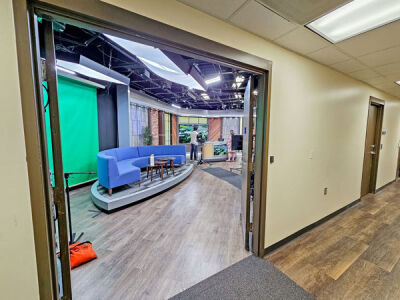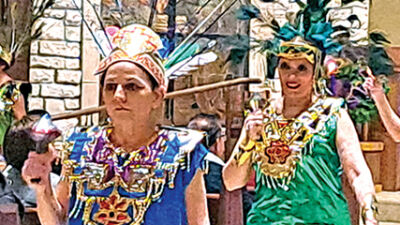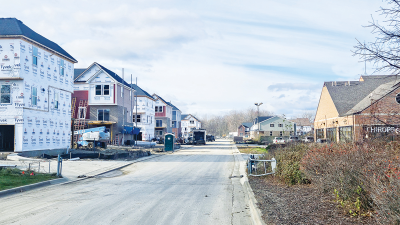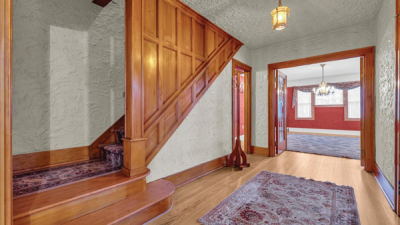
The Novi Community Relations Department, using public, educational and governmental funds, turned a storage space into a modern television and podcast production studio.
Photo by Patricia O’Blenes

Trevor Walega, Novi video production specialist, and Sheryl Walsh-Molloy, Novi director of communications, sit in front of a video wall that is set up for one of the city’s podcasts.
Photo by Patricia O’Blenes
NOVI — The city of Novi recently transformed an old storage area of the Novi Civic Center that was affectionately known as the “dungeon” into a state-of-the-art TV and podcast studio.
The studio, called “Studio No.VI,” took a little over a year to design and build. It was budgeted into the 2023-2024 city budget. Construction began in late August, and the studio officially opened in February.
The $800,000 studio was funded by public, educational and governmental funds. PEG funds are accumulated annually by the city from federal fees charged to cable consumers. One of the charges included in a cable bill is a 1% PEG fee required by federal law.
“Whether you like to pay it or not, if you have Comcast, Charter, Spectrum or AT&T, they have what they call PEG and franchise fees, and that is for use of the rights of way — for the fiber — and when we sat down maybe a couple of years ago, we had over a million dollars in PEG fees from our relationships/partnerships with those cable entities,” said Sheryl Walsh-Molloy, director of communications for the city of Novi. “The kicker is that they’re restricted funds. They can only be used for video operations.”
According to Walsh-Molloy, the city receives on average $350,000-$380,000 a year in PEG funds. The city receives the PEG funds in quarterly installments from cable companies. However, the Federal Communications Commission dictates that the funds are only able to be used for capital improvement costs associated with construction, equipment, software, warranty, labor and training for PEG access facilities. She said that prior to 2019, the city was able to fund operational budget items such as the salaries of communications employees with PEG funds, but that is no longer permitted by the FCC.
“Imagine having to spend 300 and some thousand dollars on video equipment, capital purchases, every year. So the pot continued to grow and we had a very small studio that was in a closet — literally a walk-in closet — and we said, ‘You know, social media, electronic communications changed so much over the last 20 years. … It’s progressed. We need to do something. Let’s build a studio, let’s be able to utilize it to tell the Novi stories through reels and through longer content through multiple platforms,’ and the idea of the studio came to fruition,” Walsh-Molloy said.
The 1,000-square-foot studio consists of three different sets. A green screen, a main setup with a video wall, and a standing monitor. The equipment is all mobile and can easily be switched around to provide a different backdrop, with about 180 different zones of lights. The studio is currently used for “Update Novi,” a monthly update with the mayor; “After the Gavel,” a recap of each City Council meeting; the “Now You Novi” podcast, as well as any other type of shoot that the city might need.
“One of the biggest advantages of this studio is taking advantage of having a smaller team,” said Trevor Walega, video production specialist for the city of Novi. “Normally, when we were going out on shoots prior to the studio, there was a half-day dedicated to just setup and tear down (between three employees). So,what’s great about this studio is that it can essentially be a one-man operation.”
Prior to the studio, employees would have to pack up a vast amount of gear, including cameras and lighting. Then they would have to travel to the set and set up the equipment on location and then tear it down to come back to the Civic Center and edit it. Now everything is “self-contained,” Walsh-Molloy said.
“It’s efficient,” Walsh-Molloy said.
Walega said that “After the Gavel” used to take two to three hours to complete, but now that they have the studio, it takes 15 minutes from start to finish.
“Because we have this really nice-looking set, with lighting and everything already set up, we are able to turn around content really fast,” Walega said. “All we got to do is bring a camera over here, repurpose one of these cameras, flip it around, have our talent stand up, hit record and that’s essentially it. Turn it right around. Super, super efficient, super easy and again that makes it really nice when we have lots of different formats in here turning around shorts, and just saving the time of setting up and tearing down has been huge for us.”
Walsh-Molloy said they have had the studio for less than six months and they are already finding different ways to utilize it. She said the Novi Parks Foundation has used it, they are planning a live question and answer segment with a doctor from Ascension Hospital, and they also do headshots and photos in the studio. The studio is not rented out publicly but is strictly to produce content for the city’s social media channels, website and cable channels — channel 213-1 on Spectrum and Channel 9 on AT&T.
Recently the studio was used to produce a segment on the city’s transition to People’s Express for community curb to curb transit, with a focus on services for seniors and the disabled.
“Now the attention span of somebody is two to three minutes if you’re lucky and they see a familiar happy face. So, our adeptness at telling Novi’s story has had to turn on a dime,” Walsh-Molloy said. “The big thing for me is that this was completed without using taxpayer funds, which I think is super exciting, and they were dedicated restricted funds, which had to be used for video operations. So, it’s a win-win for not only the staff, that’s Trevor, that this is a new toy box for him to play in. I mean, you look at it and I’m wowed. Every day I come in here and I’m like, ‘Gosh, this is like Channel 2, 4 and 7.’ This is quality what we have here, and what other municipality is fortunate to have that. So, for them to be video production specialists and be able to use that is a dream come true.”
“It certainly is. This just completely elevates what people are seeing from us on all channels,” Walega said. “This is just a consistent set, a consistent look. But just being able to have this kind of hub for content, to speed it up, make it faster, make it all look really nice, yeah, our pipeline is better than ever.”
Walsh-Molloy said she strives to help make the city as transparent as possible and this studio provides another avenue to do so.
The next project the city plans to tackle utilizing PEG funds is updating the City Council chamber, as the council’s meetings are televised and the chamber is technologically outdated. The PEG funds have once again increased to around $1 million dollars, so Walsh-Molloy hopes within a year or so to have that project completed.
 Publication select ▼
Publication select ▼

















